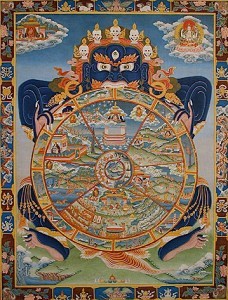
A Brief Overview of the Bardo by Thrangu Rinpoche Geshe Lharampa is a great companion to The Tibetan Book of the Dead or The Bardo Thodol. In this short text, the author gives a modern overview of the bardos and stages we go through during the days after death. At the same time, Thrangu Rinpoche Geshe Lharampa outlines what specific meditations are handy for the different obstacles. This book gave me a clearer understanding of the Bardo Thodol than the Bardo Thodol itself.
Download A Brief Overview of the Bardo here as a free PDF e-book:
 A Brief Overview of the Bardo
A Brief Overview of the Bardo
What is the Bardo in Tibetan Buddhism?
In Tibetan Buddhism, “Bardo” refers to the transitional states or “intermediate states” that mark an individual’s life from birth to death and rebirth. The concept of Bardo is most significantly elaborated upon in the “Bardo Thodol,” known in the West as the “Tibetan Book of the Dead.” This text describes the consciousness experiences after death during the interval between death and rebirth (or ultimate enlightenment), explaining how one’s future life circumstances or even liberation (enlightenment) can be influenced by one’s state of mind and actions within these phases.
There are traditionally six Bardos, though the term is most often associated with the three that are related to the death and dying process:
- “Chikhai Bardo” or “Bardo of the moment of death”: This phase starts from the onset of the dying process and continues until actual death. It is characterised by the dissolution of elements that make up a person’s physical and psychological makeup, culminating in the experience of the “clear light of reality,” which is the purest state of consciousness according to Tibetan Buddhism.
- “Chonyid Bardo” or “Bardo of experiencing reality”: If one does not achieve liberation upon recognizing the clear light at death, the consciousness wanders into this phase, experiencing visions and sounds that are the projections of one’s own mind, though they may not be recognized as such. These projections are influenced by the individual’s past actions (karma) and can be terrifying or comforting depending on one’s mental state and the actions performed during one’s lifetime.
- “Sidpa Bardo” or “Bardo of rebirth”: This phase involves the consciousness seeking and finding a new rebirth. The text details various signs and experiences associated with the process of choosing a new birth. The individual’s karma significantly influences these experiences, and the “Tibetan Book of the Dead” provides guidance for choosing a favorable rebirth or potentially achieving liberation from the cycle of birth and rebirth (samsara) altogether.
In a broader context, Bardo can refer to any transitional experience, any gap between the completion of one situation and the onset of another. Practitioners are often guided through meditative and contemplative practices to prepare for these transitions, particularly the significant journey after death, aiming for enlightenment or a favorable rebirth. These practices are meant to help the individual recognize the nature of mind and phenomena during these transitional experiences, potentially leading to a higher state of awareness or realization.


i want to know about Samsara
You are living in Samsara, liberate all living beings to liberate yourself…